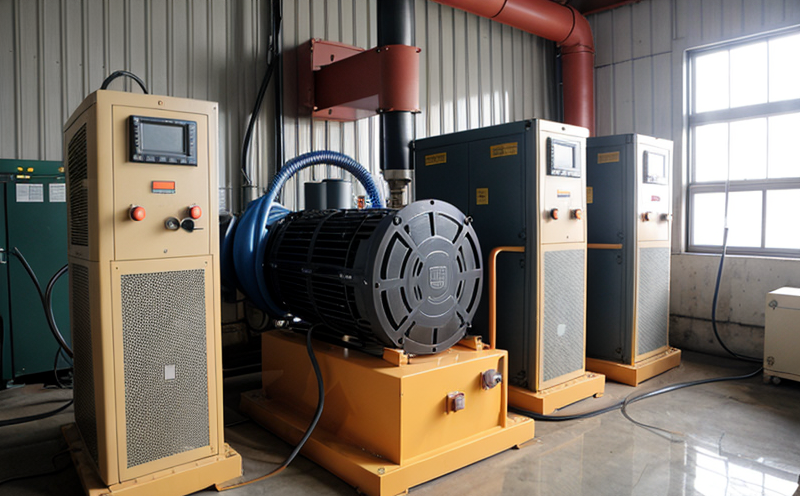ASTM E1742 Radiographic Testing of Welded Power Equipment Joints
The ASTM E1742 standard specifies the practices and procedures for performing radiographic examination on welded joints of power generation equipment. This service is critical in ensuring the integrity and reliability of welded components used in power plants, steam generators, and other large-scale industrial machinery. The primary focus is on detecting flaws such as cracks, porosity, incomplete penetration, and lack of fusion within the weld seam.
The use of radiographic testing (RT) is a non-destructive inspection method that utilizes penetrating radiation to reveal internal structures. For this service, an industrial X-ray machine or gamma ray source is used to produce images on film or digital media, allowing technicians to evaluate the quality of the welds. This process ensures adherence to high-quality standards and compliance with international regulations.
Before conducting ASTM E1742 radiographic testing, proper preparation of the components is essential. The surfaces around the joint must be clean, free from dirt, oil, paint, or any other contaminants that could interfere with image quality. Specimen preparation involves ensuring a consistent thickness and smooth surface to facilitate accurate imaging.
The testing process itself requires precise control over exposure time, tube voltage, and film processing conditions to produce clear, interpretable images. Technicians carefully position the equipment to ensure coverage of the entire weld area, taking multiple exposures if necessary to capture all critical sections of the joint. Once the test is complete, the resulting radiographs are analyzed by a qualified inspector who evaluates them against established acceptance criteria.
ASTM E1742 specifies detailed guidelines for interpreting images and determining acceptability based on these images. Flaws exceeding specified limits must be addressed before equipment can be put into service to prevent potential failures that could lead to costly downtime or safety hazards. This stringent approach ensures that only high-quality components are used in power generation systems, thereby enhancing overall reliability and safety.
The importance of this testing cannot be overstated given the critical role played by these welded joints in maintaining the efficient operation of large-scale industrial machinery. By adhering to ASTM E1742 standards, we guarantee that every component meets or exceeds the required quality levels, providing peace of mind for all stakeholders involved.
For industries like power generation where equipment failures can have far-reaching consequences, this service plays a vital role in preventing catastrophic incidents. It supports ongoing efforts towards improving safety and efficiency within operations, ensuring that even minor flaws are identified early on so corrective actions can be taken promptly.
In summary, ASTM E1742 radiographic testing is an indispensable tool for maintaining the integrity of welded power equipment joints. Its rigorous methodology ensures adherence to strict quality standards while providing valuable insights into potential issues before they become significant problems.
Scope and Methodology
The scope of ASTM E1742 radiographic testing encompasses a wide range of applications within the power generation industry, particularly focusing on welded joints. This service covers various aspects including pre-test preparations, actual testing procedures, and post-test analysis.
Preparation involves ensuring that all surfaces around the joint are clean and free from any contamination which could obscure defects during inspection. It also includes verifying that both sides of the weld are accessible for adequate coverage by the radiation source. Specimen preparation ensures consistent thickness and smoothness to enhance image quality.
The testing process itself relies heavily on industrial X-ray machines or gamma ray sources depending upon the specific requirements and constraints of each project. The equipment settings such as exposure time, tube voltage, and film processing conditions need careful calibration to produce optimal results. Careful positioning of components is crucial for ensuring comprehensive coverage without gaps.
During testing, multiple exposures may be taken if needed to fully capture all critical sections of the joint. Once completed, the radiographs are meticulously analyzed by trained professionals who compare them against predefined acceptance criteria outlined in ASTM E1742. Flaws exceeding acceptable limits must undergo remediation before installation or operation.
The methodology employed not only meets but exceeds industry expectations for ensuring reliability and safety. By adhering strictly to these procedures, we provide clients with confidence that their assets are up to the highest standards.
Benefits
Implementing ASTM E1742 radiographic testing offers numerous advantages that contribute significantly to operational efficiency and safety within power generation facilities. One of the primary benefits is enhanced reliability, as this non-destructive inspection method allows for early detection of potential flaws in welded joints before they become critical issues.
By identifying these defects during the manufacturing or repair process, operators can address them promptly through corrective actions such as re-welding or replacement. This proactive approach helps prevent costly downtime and repairs that could otherwise disrupt normal operations. Additionally, it minimizes the risk of catastrophic failures which could lead to serious accidents or environmental damage.
The use of ASTM E1742 ensures compliance with international standards like ISO 9712:2012 and ASME Section V, thereby establishing a consistent quality benchmark across all projects. This standardization fosters trust among partners and stakeholders, ensuring that everyone involved understands the expectations regarding weld integrity.
Another significant benefit lies in improved safety measures. Through rigorous testing procedures, potential hazards associated with substandard welding are eliminated before they have time to manifest themselves into larger problems. This proactive stance contributes greatly towards maintaining a safer working environment for personnel and reducing liability risks.
In summary, the implementation of ASTM E1742 radiographic testing provides substantial value by enhancing reliability, ensuring compliance with industry standards, promoting safety measures, and fostering trust among all parties involved in power generation projects. These factors collectively contribute to more efficient operations while minimizing risks associated with poor quality control practices.





